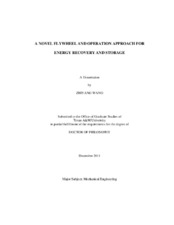| dc.description.abstract | Flywheel has intrinsic advantages over other energy storage forms such as hydraulic storage, batteries and compressed airs. These advantages include higher robustness, longer life cycle, great energy density, higher efficiency, lower loss, better discharge depth and relatively easier recycling, etc.
In this dissertation a novel shaftless flywheel was developed. The most important feature of our novel design is the integration of the motor generator and the magnetic suspension into the flywheel disk, which removes the need for a support shaft and enables our solid disk design. This design was shown to have big advantages than traditional designs using annular discs press-fitted on shafts. This was illustrated by a comparison between annular and solid 4340 discs in stress levels, SN lives and fatigue lives with cracks. Due to the scale of the system, our rotating speed is relatively lower than traditional designs. This makes possible the usage of unlaminated magnetic bearings to reduce the system cost at partial expense of the system performance.
A 4340 steel sample was tested to retrieve its magnetic behavior. The novel magnetic levitation was then designed using ANSYS static analysis based on the measured data. The position stiffness and current stiffness were retrieved with the analysis.
The eddy losses of the magnetic bearings were retrieved through FEM motor software CARMENTM by Vector FieldTM. The total bearing loss was calculated based on the simulated eddy loss and measured hysteresis loss on 4340. The system equilibrium temperature was simulated with ANSYSTM.
The Frequency weakening effect of the magnetic bearing was analyzed with ANSYSTM harmonic analysis. The closed-loop control stability of the system was investigated based on the results.
A motor design concept was proposed with the variable motor/generator gain capability. This capability was a key feature in optimizing the charge/discharge performances of the flywheel in both grid level and hybrid locomotive applications.
Based on EPA average data, the benefits of our hybrid locomotives on fuel and NOx savings were simulated on various train operations. The optimization for regenerative braking was also discussed. The dissertation concludes with the discussion of the flywheel system isolation from train operation induced vibrations. | en |


